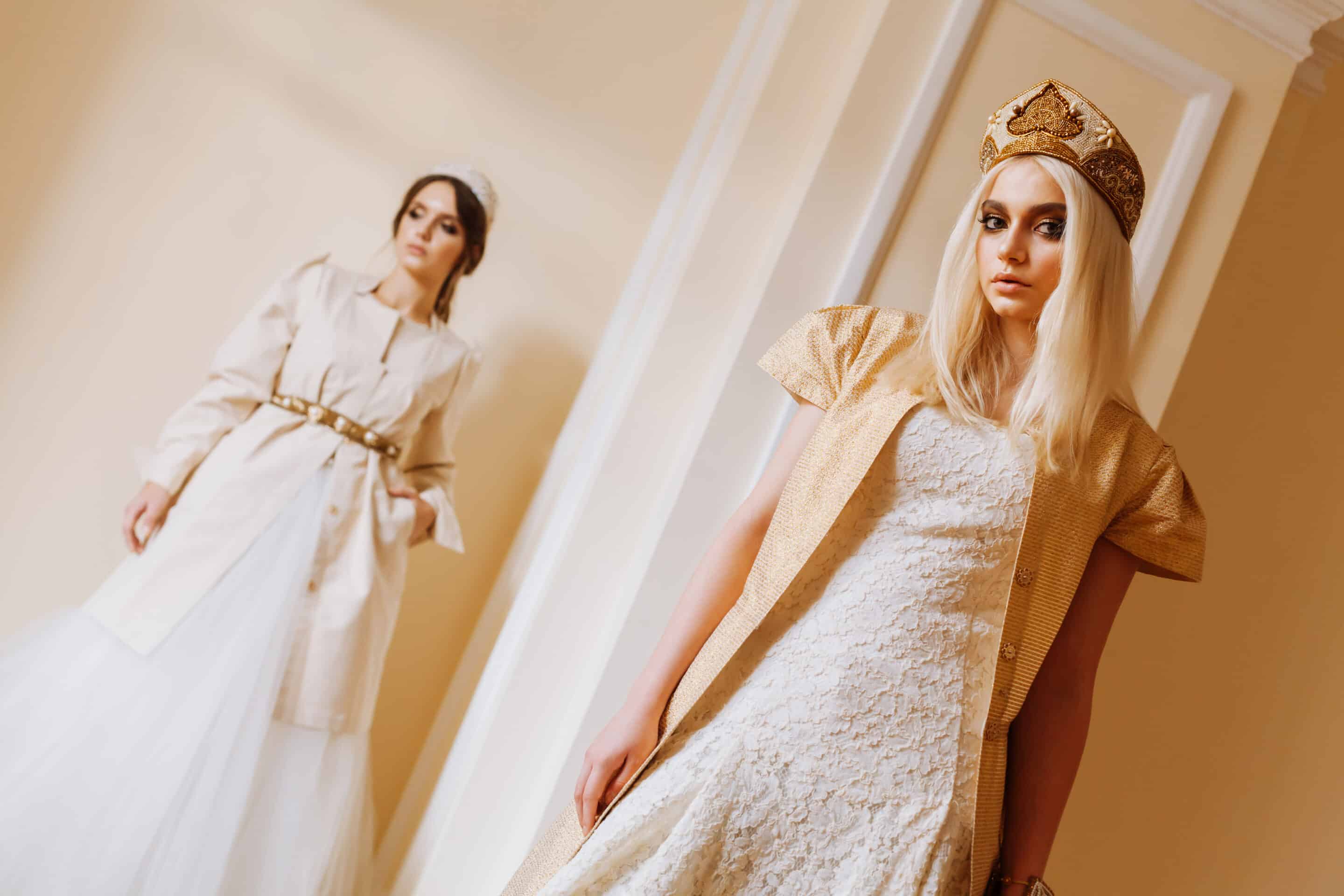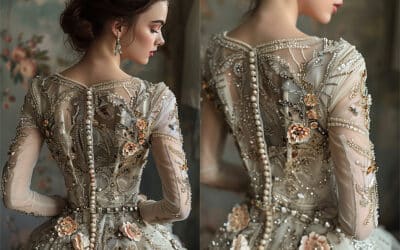Wedding dresses are often imagined as pure white gowns, but history tells a more colorful story. Before white became the standard in Chicago and around the world, brides wore dresses in a variety of shades that reflected their culture, social status, and personal taste. Let’s explore how wedding dress colors evolved, and what brides in Chicago wore before white took over.
Early Wedding Dress Traditions in Chicago
In the 19th and early 20th century, brides in Chicago often wore dresses they already owned. Weddings were community celebrations, but not everyone could afford a gown made just for the occasion. Instead of white, brides chose practical colors that could be reused.
Deep hues, such as brown, burgundy, navy blue, and even dark green, were common choices. These colors not only symbolized strength and tradition but also held up better to repeated wear than white fabrics, which stained easily.
Many local brides have also passed down gowns through generations, which have been later restored through gown restoration services.
Practical Dresses for Everyday Use
In the 19th century, many Chicago brides wore dresses that could be reused after the ceremony. Practicality was the main factor, especially for working-class families.
Dark and Sturdy Fabrics
Colors such as navy, brown, and burgundy were chosen for their durability and rich, deep tones. These gowns resisted stains and lasted longer than delicate white fabrics.
Family Heirlooms and Hand-Me-Downs
It was common for mothers or older sisters to pass down gowns, often tailored to fit the bride. This kept traditions alive within families.
Community Celebrations Over Luxury
The focus was less on the gown’s color and more on the celebration itself, which centered on family, church, and community.
The Rise of White Wedding Dresses
The popularity of white gowns in Chicago grew after Queen Victoria’s 1840 wedding, which influenced American bridal fashion. Wealthy families began to adopt the trend, using white silk or lace to accentuate their status and luxury. However, white did not immediately dominate in Chicago.
Many immigrant communities, mainly Irish, Polish, and Italian families, continued to favor colorful dresses rooted in cultural tradition well into the early 20th century. Today, modern brides still honor their heritage by blending tradition with contemporary touches, such as cleaning and preserving their wedding dresses.
Influence of Queen Victoria
When Queen Victoria wore white in 1840, it set a fashion trend that quickly spread across Europe and America.
Chicago’s Wealthy Families Adopt White
In the late 19th century, affluent Chicago brides began favoring white silk and lace gowns as symbols of luxury and refinement.
Department Stores Popularize White
Downtown Chicago stores marketed white dresses as the “ideal” bridal look, making them more accessible to middle-class brides.
Slow Transition Among the Working Class
Many working-class and immigrant families continued to choose practical colors until well into the 20th century.
Symbolism Behind Wedding Dress Colors
Colors carried deep meaning in the past, and Chicago brides selected gowns that reflected values and beliefs. For many families, the color choice was not just about style, but about what the color represented for the marriage.
Blue represented loyalty and devotion, while red was associated with passion and prosperity. Darker colors, such as black or brown, symbolized dignity and practicality. These meanings shaped how brides approached their big day, ensuring that their gown reflected their personal and cultural values.
Common Color Meanings
- Blue: Faith, devotion, and sincerity
- Red: Joy, fertility, and wealth
- Black: Elegance, dignity, and practicality
Influence of the Economy on Bridal Fashion
Before white gowns became popular in Chicago, economics played a huge role in what brides wore. Most working-class families couldn’t afford a dress for just one occasion. Instead, they chose strong, dark fabrics that could last for years and serve multiple purposes.
Economic hardships, particularly during the Great Depression, reinforced the trend of selecting practical colors such as brown, gray, and navy. These dresses reflected financial reality but still allowed brides to celebrate their weddings with pride.
Economic Factors That Shaped Dress Colors
- The cost of fabric and dyes
- Reuse of dresses for daily or church wear
- Cultural frugality in immigrant communities
Popular Wedding Dress Colors Before White
Before white became the symbol of purity and elegance, Chicago brides often embraced vibrant colors that carried deep, meaningful significance.
- Blue: Symbolized loyalty and faithfulness, often chosen by Christian brides.
- Black: Common in Scandinavian and European traditions, especially for practical reuse.
- Red: Represented love, joy, and prosperity in many cultural weddings.
- Green: Linked with fertility and growth, though sometimes avoided as “unlucky.”
- Brown & Gray: Everyday practical shades, especially among working-class families.
These gowns were not only practical but also deeply tied to cultural and social values.
Wedding Dress Colors in Immigrant Communities
Chicago’s rich immigrant history influenced bridal fashion. Polish and German brides often wore blue gowns, symbolizing devotion. Italian brides sometimes chose deep red or gold, connecting the wedding to traditions of wealth and festivity.
Scandinavian families leaned toward black dresses, which could be worn again for formal occasions. These traditions highlight how Chicago’s diversity kept wedding fashion colorful long before white became a universal standard.
Irish Traditions
Irish brides often wore blue rather than white, symbolizing faith and devotion.
Italian Customs
Italian brides often favored red or gold, colors that symbolized joy, love, and prosperity.
Scandinavian Practices
Scandinavian families favored black gowns, which could be reused for other formal occasions.
Blending Old and New Traditions
Some brides combined cultural colors with modern trends, wearing colorful gowns for the reception and lighter shades for the ceremony.
Preservation of Historic Wedding Dresses
Many families in Chicago still treasure heirloom dresses that were not white. Whether blue, black, or burgundy, these dresses tell stories of resilience and culture. Modern brides often turn to wedding dress cleaning and restoration experts to preserve these garments for future generations.
Challenges With Colored Fabrics
Darker dyes and fabrics required careful maintenance, as some colors faded faster over time.
Modern Cleaning and Restoration
Today, experts can restore heirloom dresses—whether white, blue, or black—using specialized techniques.
Passing Dresses Through Generations
Many Chicago families preserve gowns as family treasures, handing them down to daughters and granddaughters.
Museums and Historical Collections
Some historically significant gowns are preserved in Chicago museums, showcasing the city’s cultural wedding traditions.
Transition From Color to White
The shift from colorful gowns to white was gradual in Chicago. Wealthy brides began adopting white silk and lace as a symbol of status in the late 19th century. Department stores in downtown Chicago soon marketed white gowns as the “ideal” for brides, making them more desirable.
However, it wasn’t until the mid-20th century that white became the dominant choice across all social classes. Advertising campaigns and Hollywood films helped spread the idea of the “perfect white wedding.”
Key Turning Points
- 1840s: Queen Victoria’s influence spreads to America
- Early 1900s: White were marketed as fashionable in Chicago shops
- Post-World War II: White becomes a cultural standard
Cultural Traditions That Kept Colors Alive
Even as white grew in popularity, many cultural traditions in Chicago continued to hold onto colorful gowns. Irish brides often favored blue, Italian brides sometimes wore red or gold, and Scandinavian brides leaned toward black for its elegance.
These traditions continued well into the 20th century, with families blending old-world customs with new American influences. In some cases, brides wore a white gown for the ceremony but changed into a colorful dress for the reception.
Cultural Influences in Chicago
- Irish brides: Blue gowns for devotion
- Italian brides: Red and gold for celebration
- Scandinavian brides: Black for tradition and reuse
Visit For Information:
- How to Store a Wedding Dress for 2 Years in Chicago?
- What Does a White Wedding Dress Symbolize?
- Best Way to Preserve a Wedding Dress in Chicago
Information on Textile Conservation:
For a deeper dive into textile history and preservation, read this comprehensive guide from Wikipedia: Conservation and Restoration of Textiles.
FAQs
Were most brides in Chicago wearing white before 1900?
No, most brides wore darker or colorful dresses that could be reused. White became more popular after 1900.
Why did white become the standard?
White gained popularity after Queen Victoria’s wedding and grew as a symbol of wealth, purity, and fashion.
What was the most common color before white?
Blue and brown were among the most popular colors, especially among working-class Chicago families.
Did immigrant brides follow the white dress trend?
Not immediately. Many immigrant communities held onto colorful traditions for decades.
Were black wedding dresses everyday?
Yes, especially in Scandinavian and European communities in Chicago.
Did brides ever wear patterned fabrics?
Yes, floral and embroidered dresses were popular among those who sought color and vibrancy.
Were red dresses popular in Chicago?
Red dresses were worn in Italian and some Eastern European traditions, symbolizing joy and love.
How did practicality affect dress color?
Brides chose dark, sturdy fabrics that could be reworn for Sunday services and events.
Were wedding dresses always floor-length?
Not always. In some immigrant families, knee-length or ankle-length dresses were a common choice.
Can older, colored dresses be preserved today?
Yes, with modern preservation methods, even century-old gowns can be restored and safely stored.






